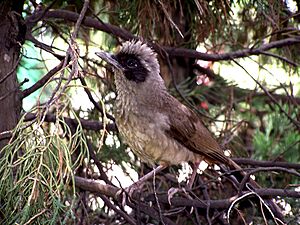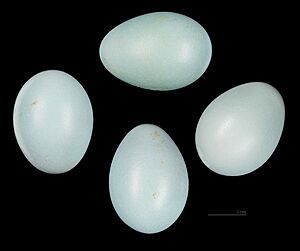Masked laughingthrush facts for kids
Quick facts for kids Masked laughingthrush |
|
|---|---|
 |
|
| Conservation status | |
| Scientific classification | |
| Synonyms | |
|
Garrulax perspicillatus |
The masked laughingthrush is a cool bird. It gets its name from the dark feathers around its eyes. These feathers look like a mask or spectacles. This bird lives in China and Vietnam.
You can often spot masked laughingthrushes in groups. They usually fly around in small, noisy flocks of about seven birds. In China, people even call them "seven sisters." This name comes from their habit of staying together.
Understanding the Masked Laughingthrush Name
How Scientists Named This Bird
Scientists give every animal a special two-part name. This is called a binomial name. It helps everyone know exactly which animal they are talking about. The masked laughingthrush's scientific name is Pterorhinus perspicillatus.
A German scientist named Johann Friedrich Gmelin first described this bird in 1789. He wrote about it in a famous book called Systema Naturae. This book was first started by Carl Linnaeus. Gmelin first put the bird in a group called Turdus, which are thrushes.
The second part of its name, perspicillatus, is from Latin. It means "spectacled." This describes the bird's mask-like eye feathers. Gmelin learned about this bird from a French scientist. This scientist had described it as "Le Merle de la Chine," or "The Thrush of China."
Changing Bird Groups
For a long time, the masked laughingthrush was in a bird group called Garrulax. But scientists keep learning new things about animals. They use special tests to study how birds are related.
In 2018, a big study looked at many laughingthrushes. This study used molecular phylogenetic methods. It helped scientists understand bird family trees better. Because of this study, the masked laughingthrush moved to a different group. It is now in the group called Pterorhinus.
This Pterorhinus group was actually named a long time ago, in 1868. It was brought back for birds like the masked laughingthrush. This bird is also monotypic. This means there are no different types or subspecies of the masked laughingthrush. It is just one kind of bird.



